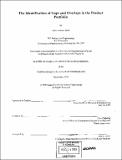The identification of gaps and overlaps in the product portfolio
Author(s)
Hull, John Andrew, 1974-
DownloadFull printable version (13.54Mb)
Other Contributors
Massachusetts Institute of Technology. Dept. of Mechanical Engineering.
Advisor
Don Clausing.
Terms of use
Metadata
Show full item recordAbstract
In product development organizations, the front end of product development is usually confined to planning within business units for product families and individual products. This can pose a problem for businesses, as individual business units and development teams do not think in terms of the big picture of the company. Business units are responsible for only their market and product strategies, and are relatively unconcerned about those of other business units. Because of this, there is the potential for product offerings across business units to overlap in the marketplace, thereby wasting development resources and confusing customers with multiple offerings of similar value propositions. There is also the potential to have gaps in the marketplace, where no business units have product offerings, which can be a prime niche for competitors to introduce products to gain a market foothold and precious market share. The purpose of this research was to "extend" the front end of the development process upward across all business units in order to understand the market relationships across the entire product-offering portfolio. This allows the company to see how its products are related across markets, and to observe the strengths and weaknesses in il'> competitive positions. The result is a better understanding of which markets and products should be prioritized when making investment decisions. This thesis develops and discusses several concepts and tools, namely those of the Core Benefit Proposition and Vector of Differentiation, that are necessary in order to identify the gaps and overlaps within a product portfolio. A basic approach was developed that combines these concepts and tools into a framework for identifying gaps and overlaps. This approach was then applied and demonstrated with a case study involving the product portfolio of the Xerox Company.
Description
Thesis (S.M.)--Massachusetts Institute of Technology, Dept. of Mechanical Engineering, 1999. Includes bibliographical references (p. 139-140).
Date issued
1999Department
Massachusetts Institute of Technology. Department of Mechanical EngineeringPublisher
Massachusetts Institute of Technology
Keywords
Mechanical Engineering.